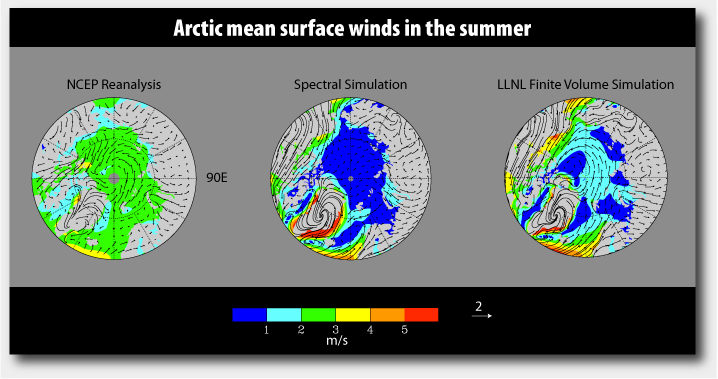High-resolution climate simulations with Thunder
Using state-of-the-art supercomputers, Laboratory climate scientists have performed a 400-year high-resolution global ocean-atmosphere simulation with results that are more similar to actual observations of surface winds and sea surface temperatures.
The research, led by LLNL atmospheric scientist Govindasamy Bala, appears in the April 1 edition of the Journal of Climate .
The researchers used the Community Climate System Model (CCSM), which is sponsored by the National Science Foundation and Department of Energy. CCSM is a global ocean-atmosphere modeling framework designed to simulate the climate of the Earth. It is a comprehensive general circulation model that consists of complex submodels for the atmosphere, ocean, ice and land.
In the earlier versions, spectral methods were available to solve the transport of water vapor, temperature and momentum in the atmosphere. In the LLNL simulation, the researchers assessed the performance of a new dynamical method for atmospheric transport that was developed at NASA by Ricky Rood (a co-author of the study at the University of Michigan) and Shian-Jiann Lin of the National Oceanic and Atmospheric Administration. The new method is called finite volume transport.
The Livermore team found substantial improvements in the simulated global surface winds and sea surface temperatures. Team members also noted large improvements in the simulation of tropical variability in the Pacific, distribution of Arctic sea ice thickness and the ocean circulation in the Antarctic Circumpolar Current.
"We found that this coupled model is a state-of-the-art climate model with simulation capabilities in the class of those used for assessments for the Intergovernmental Panel on Climate Change (IPCC)," Bala said.
The simulation was performed on the LLNL supercomputer Thunder, using about 500 processors or slightly more than 10 percent of Thunder’s capacity. The 400-year-long simulation, performed over a period of three months, was part of an LLNL Grand Challenge Computing project. This simulation, at about 100-kilometer resolution for the atmosphere, is the highest resolution multi-century CCSM simulation to date.
Under the same Grand Challenge Computing project, the researchers earlier performed a 1,000-year-long simulation corresponding to the climate of pre-industrial times, which enabled the scientists to estimate the "climate noise" in frost days, snow depth and stream flow in the Western United States. The collaborative study between LLNL and the Scripps Institution of Oceanography, which appeared in a Science article earlier this year, pointed to humans as the cause of that regional diminishing water flow.
The present study is a collaborative effort by LLNL, the University of Michigan, Scripps Institution of Oceanography and the National Center for Atmospheric Research (NCAR). Other LLNL researchers include Art Mirin, Julie McClean, Dave Bader, Peter Gleckler and Krishna Achuta Rao (who is now at the Indian Institute of Technolog, Delhi).






